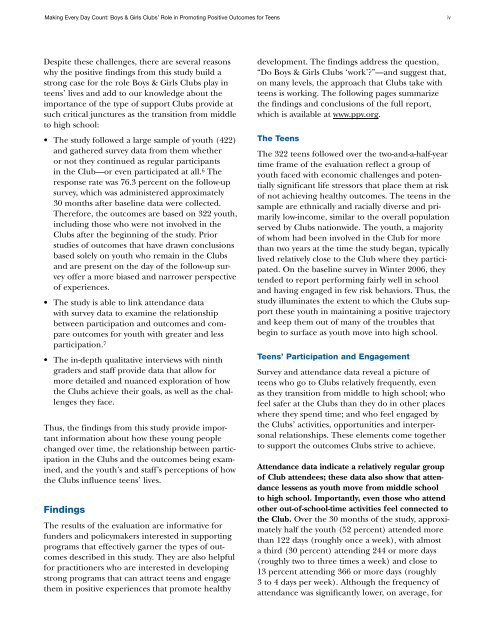Making Every Day Count - Teens
Making Every Day Count - Teens
Making Every Day Count - Teens
Create successful ePaper yourself
Turn your PDF publications into a flip-book with our unique Google optimized e-Paper software.
<strong>Making</strong> <strong>Every</strong> <strong>Day</strong> <strong>Count</strong>: Boys & Girls Clubs’ Role in Promoting Positive Outcomes for <strong>Teens</strong>ivDespite these challenges, there are several reasonswhy the positive findings from this study build astrong case for the role Boys & Girls Clubs play inteens’ lives and add to our knowledge about theimportance of the type of support Clubs provide atsuch critical junctures as the transition from middleto high school:• The study followed a large sample of youth (422)and gathered survey data from them whetheror not they continued as regular participantsin the Club—or even participated at all. 6 Theresponse rate was 76.3 percent on the follow-upsurvey, which was administered approximately30 months after baseline data were collected.Therefore, the outcomes are based on 322 youth,including those who were not involved in theClubs after the beginning of the study. Priorstudies of outcomes that have drawn conclusionsbased solely on youth who remain in the Clubsand are present on the day of the follow-up surveyoffer a more biased and narrower perspectiveof experiences.• The study is able to link attendance datawith survey data to examine the relationshipbetween participation and outcomes and compareoutcomes for youth with greater and lessparticipation. 7• The in-depth qualitative interviews with ninthgraders and staff provide data that allow formore detailed and nuanced exploration of howthe Clubs achieve their goals, as well as the challengesthey face.Thus, the findings from this study provide importantinformation about how these young peoplechanged over time, the relationship between participationin the Clubs and the outcomes being examined,and the youth’s and staff’s perceptions of howthe Clubs influence teens’ lives.FindingsThe results of the evaluation are informative forfunders and policymakers interested in supportingprograms that effectively garner the types of outcomesdescribed in this study. They are also helpfulfor practitioners who are interested in developingstrong programs that can attract teens and engagethem in positive experiences that promote healthydevelopment. The findings address the question,“Do Boys & Girls Clubs ‘work’?”—and suggest that,on many levels, the approach that Clubs take withteens is working. The following pages summarizethe findings and conclusions of the full report,which is available at www.ppv.org.The <strong>Teens</strong>The 322 teens followed over the two-and-a-half-yeartime frame of the evaluation reflect a group ofyouth faced with economic challenges and potentiallysignificant life stressors that place them at riskof not achieving healthy outcomes. The teens in thesample are ethnically and racially diverse and primarilylow-income, similar to the overall populationserved by Clubs nationwide. The youth, a majorityof whom had been involved in the Club for morethan two years at the time the study began, typicallylived relatively close to the Club where they participated.On the baseline survey in Winter 2006, theytended to report performing fairly well in schooland having engaged in few risk behaviors. Thus, thestudy illuminates the extent to which the Clubs supportthese youth in maintaining a positive trajectoryand keep them out of many of the troubles thatbegin to surface as youth move into high school.<strong>Teens</strong>’ Participation and EngagementSurvey and attendance data reveal a picture ofteens who go to Clubs relatively frequently, evenas they transition from middle to high school; whofeel safer at the Clubs than they do in other placeswhere they spend time; and who feel engaged bythe Clubs’ activities, opportunities and interpersonalrelationships. These elements come togetherto support the outcomes Clubs strive to achieve.Attendance data indicate a relatively regular groupof Club attendees; these data also show that attendancelessens as youth move from middle schoolto high school. Importantly, even those who attendother out-of-school-time activities feel connected tothe Club. Over the 30 months of the study, approximatelyhalf the youth (52 percent) attended morethan 122 days (roughly once a week), with almosta third (30 percent) attending 244 or more days(roughly two to three times a week) and close to13 percent attending 366 or more days (roughly3 to 4 days per week). Although the frequency ofattendance was significantly lower, on average, for


